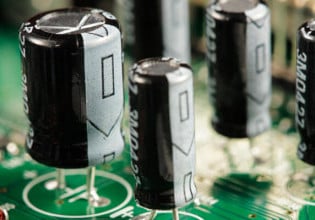Motor Starters Part 1: Direct On-Line
This article introduces electrical and power system engineers to the direct on-line motor starter, including principles, operation, wiring, parts, advantages, disadvantages, and applications.
Many methods for starting induction motors exist. Induction motors draw too much starting current and need protection against this high current that can destroy the windings. Starters are the key components that protect the induction motor against this overvoltage. Among the starters employed in the process, the Direct On-Line (DOL) starter is the simplest form available in power electronics. The DOL comprises the circuit breaker, overload relay, and an electromagnetic contactor.
The contactor is controlled by independent start and stop push buttons with an auxiliary contactor contact connected across the start push button where the contactor is latched electrically any time the motor is operational.
Direct On-Line Starter Principles
In the beginning, the circuit contactor is closed such that it supplies maximum line voltage to the inductor motor winding. The induction motor will draw a very high amount of inrush current for a very short duration. The current will slowly be limited to the induction motor's locked rotating armature current. At this moment, the induction motor develops locked rotating armature torque and accelerates toward full motor speed.
In the process of the motor accelerating, it experiences a drop in the current, but the decrease is not that significant before the motor gets to the highest desired speed. The loading on the motor affects the time the motor takes take to accelerate from zero to maximum or full speed and, therefore, the time the high starting current lasts. This, however, does not determine the starting current magnitude.
Provided that the motor produces higher torque than the load throughout the acceleration, it is obvious that it will achieve full speed. If the load torque exceeds that produced by the motor at any point during the acceleration, then the motor stops accelerating. When the motor starting torque using the DOL starter becomes insufficient to support the load, replace the motor with another one that can develop enough starting torque.
Note that the induction motor develops the accelerating torque without involving the load. It changes with time as the motor accelerates due to the load torque speed curve and motor torque speed curve. The motor starting time depends on the inertia of the load and the accelerating torque.

Figure 1. Typical torque-speed curve of an induction motor. Image used courtesy of Simon Mugo
DOL Starters Parts
The DOL starter comprises the following parts:
Contactors and Coil
The contactors used in the DOL starters are switches that are operated electromagnetically. They provide a very safe and flexible mode of interrupting and connecting branch circuits.
It consists of an electromagnet made up of a wire coil placed in an iron core. Connecting current to flow through the wire coil magnetizes the iron, which attracts another iron bar called an armature. Anytime there is an interruption of the current flowing through the coil, it causes the armature to drift away from the contact due to demagnetization.
Any control machine that uses electric motors has contactors that are used to control them. For single-phase motors, 230 V-rated coils are used. For three-phase motors, 415 V-rated coils are used. The three main O-labeled contacts and auxiliary contacts are less powerful in the contactor.

Magnetic contactor. Image used courtesy of MEP Technical World
Overload Protection Relay
The overload protection is a very significant component of the DOL starter circuit. It protects the motor against burnout and ensures it operates at maximum life.
Under overload, an electric motor is forced to draw excessive currents, which increase the motor temperature through overheating. Overheating causes wear and tear on the motor winding, and hence a motor must operate under established temperature limits. The overload relays play this role and ensure that the motor operates under the required conditions.

Overload relays. Image used courtesy of MEP Technical World
DOL Starter Wiring
Main Contact
Connect the contactor among the relay coil, supply voltage, and overload protection relay.
- Connect L1 from the contactor to Red-Phase, passing through the MCCB
- Connect L2 from the contactor to Yellow-Phase, passing through the MCCB
- Connect L3 from the contactor to Blue-Phase, passing through the MCCB
NO Contact
This closes when a relay is energized. Represented by 13-14 and 53-54. NO means Normally Open contact.
- 53- Connect to start button point 94
- 54- Connect to the start/stop button common wire.
NC Contact
Points 95-96 represent normally closed contact
Connection of the Relay Coil
A1 connected to any of the supply phases.
A2 connected to point 95 of the overload relay.
Connection for the Thermal Overload Relay
Connect T1, T2, and T3 to the thermal overload relay.
Connect the overload relay between the motor and the main contactor.
Connect thermal overload relay 95-96 to the stop button and start/start the common connection.
DOL Starter Wiring Diagram

Figure 2. DOL starter wiring diagram. Image used courtesy of Simon Mugo
Starting Characteristics
- Peak starting torque is 100%
- Starting current available is 100%
- Peak starting current is 6 to 8 that of the full load current
DOL Starter Advantages
- Cheap and economical amongst all other starters
- Easy to design, operate, and carry out maintenance
- Has the simplest control circuit
- Offers 100% torque during starting time
- Easy to troubleshoot
- One size of cabling is required for the whole circuitry
- Motor connection is in the delta method at the terminals of the motor
DOL Starter Disadvantages
- The starter does not minimize the motor starting current
- Very high motor starting current
- Reduced life due to thermal stress
- It experiences very high starting torque.
The DOL starter finds many applications in smaller motors like water pumps, compressors, conveyor belts, and fans.
Part 2 in this series will cover the selection and sizing of DOL motor starter parts like circuit breakers, contactors, and thermal overload relays.






